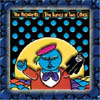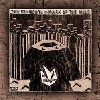I don't remember much about our plots, but I rememberthey were good. Our pal Steve was the editor of the features section forthe newspaper and was the enabler for our serial silliness. After aboutfour or five episodes, Noah and I ran out of either fodder or interest forour stories. The Residents had a similar fling with the subterranean in1983. The band's dalliance lasted only slighted longer than ours, andboth produces a similarly important corpus of work.
Mute
The Residents devised the Mole Trilogy around 1980 to be actually a pair oftrilogies which would both narrate and document the story of the Molepeople. The short story of the Moles is that they were forced leave theirsubterranean home because of religious superstition. They ended upmigrating to the west coast of their world and clashing with theindigenous Chub race. As The Residents scripted it, the story clumsilyunfolds to suggest resonances of various socio-political situations inAmerica and beyond, complete with a hybrid race of Moles and Chubs forminga pop group called The Big Bubble. One of the trilogies of albums wasdesigned to narrate the tales of the Moles and Chubs, while the other wasto serve as anthropological field recordings of the Mole and Chub races,documenting the culture of both civilizations. As you might surmise, thearc of this project was ambitious and it fizzled before it ever really gotrolling. The concept tour was planned but never executed and thetrilogies were aborted after half of the albums were completed. (I canpicture boxes of Mole stickers sitting in someone's San Francisco basementright now. ) Much of the enigmatic project was typical of thehyper-enigmatic Residents, but since they did manage to record three ofthe six albums from the pair of trilogies, they have been reissued withsome critical liner notes and some fancy booklet-style packaging.
 The Tunes of Two Cities and The Big Bubble survive as partsone and two of the anthropological trilogy. Two Cities interlacessongs from the Moles and the Chubs predating the emigration of the Moles.The songs culled from Mole culture are full of darkness, cacophony, andreverb. Conversely, the songs culled from Chub culture tend more towardsthe outwardly poppy: more piano, brighter arrangements, and loftierfeelings. All songs are largely instrumental, though intoned chantingdoes occur on songs like "Happy Home," "God of Darkness," and "A Maze ofJigsaws." The chants sounds as though they could be incidental vocals,caused more by the stirrings of inanimate instruments than animate voices.Though I find the music of both civilizations mostly unlistenable, let'stalk about the Chubs' music first. "Serenade for Missy" is Chubic musicat its best, full of stilted guitar, horns, and strings. It's big bandmusic played by humanoids without the full complement of a human genome.There is something slow and awkward about the arrangement which gives theimpression that you are privy to a civilization just learning what it cando with music. "Smack Your Lips (Clap Your Teeth)" might mimic the doubleimperative appellation of a band like Clap Your Hands Say Yeah, but don'texpect any of the David Byrne hero worship which said band usuallyemploys. Instead, there are maddening flourishes powered by a samplerwhich repeat indefinitely. "Song of the Wild" is the strongest Chub tunebecause of its intermittent moodiness which hangs like a grey cloud on ahorizon which was undoubtedly was cut with the silhouettes of approachingMoles. Such indecision and sadness has never been isolated in suchsoulless music.
The Tunes of Two Cities and The Big Bubble survive as partsone and two of the anthropological trilogy. Two Cities interlacessongs from the Moles and the Chubs predating the emigration of the Moles.The songs culled from Mole culture are full of darkness, cacophony, andreverb. Conversely, the songs culled from Chub culture tend more towardsthe outwardly poppy: more piano, brighter arrangements, and loftierfeelings. All songs are largely instrumental, though intoned chantingdoes occur on songs like "Happy Home," "God of Darkness," and "A Maze ofJigsaws." The chants sounds as though they could be incidental vocals,caused more by the stirrings of inanimate instruments than animate voices.Though I find the music of both civilizations mostly unlistenable, let'stalk about the Chubs' music first. "Serenade for Missy" is Chubic musicat its best, full of stilted guitar, horns, and strings. It's big bandmusic played by humanoids without the full complement of a human genome.There is something slow and awkward about the arrangement which gives theimpression that you are privy to a civilization just learning what it cando with music. "Smack Your Lips (Clap Your Teeth)" might mimic the doubleimperative appellation of a band like Clap Your Hands Say Yeah, but don'texpect any of the David Byrne hero worship which said band usuallyemploys. Instead, there are maddening flourishes powered by a samplerwhich repeat indefinitely. "Song of the Wild" is the strongest Chub tunebecause of its intermittent moodiness which hangs like a grey cloud on ahorizon which was undoubtedly was cut with the silhouettes of approachingMoles. Such indecision and sadness has never been isolated in suchsoulless music.
The Mole sounds are largely grim. "A Maze of Jigsaws" starts out withsome deflating squawks and makes me want to listen to AZ's Music forScattered Brains and embrace it more. The circus noises give way adark and spiraling death drone, ironically easier to listen to than thefirst half of the song. The other five songs are a deliberate descentinto further Mole mayhem. If the Chubs' songs were the Apollonian birthof musical forms, than the Moles' songs are most certainly the Dionysiacdestruction of these forms. Encased in the Mole music is totalobliteration of musical order and learning. Instead of music for theconnoisseur, you have music for the dreary and depressed masses; theworking man's soundtrack. Stay far away if you want avoid sunken-couchalcoholism by the end of the working day. But if you must listen, atleast try to envision these songs as the soundtrack to an episode ofDoctor Who, Pertwee-era.
The most impressive thing about The Big Bubble was ostensibly itsoriginal gatefold packaging. I won^Rt even pretend to understand the forceof the meta-referential retardation which went on with the originalrelease, but the liner notes with the reissue attempt to shed the variouslayers of the artsy onion created by the Residents. As for the music,recall that this is supposed to be a document of the pop super-groupformed by hybrid Moles and Chubs. The songs are cavernous, sometimesplayful, and constantly unintelligible. All in all, this is a far betterlisten than the field recordings from The Tunes of Two Cities.Listen to "Hop a Little" and try not to imagine the horrible dungeontorture scenes replete with salt and razor wire which I conjured in myhead. The song is like a passion play between torturer and prisoner; themusic is frighteningly convincing as stunning dialog. "Cry for the Fire"actually strives for the anthemic and nearly reaches it. By this point,the songs are threatening to be understood instead of simply being aragout of nonsense and fabricated language. A few more songs and you cometo the end of the album. Suddenly, the band has evolved into a truer popband than when they began. As with the earlier anthropological album, youas the listener are witness to the evolution of music theory. This one ismore rewarding than the previous, though.
samples:
 Mark of the Mole theoretically tells the story of the Mole peopleas they emigrate from their home to the land of the Chubs. Besides PennJillette's ominous weather report in the beginning of "Voices of the Air,"nothing feels particularly narrative about the album. It would be likeinterpolating the plot details of "Willy Wonka and the Chocolate Factory"by analyzing the lyrics of the various ditties and numbers from the film.If you can glean anything from the Oompa Loompa song, you are a betterreader than I. As such, most of the Mole saga has to be extrapolated fromthe liner notes. The musical soundtrack to the story is plodding,shattered, and caustic. It certainly feels like a score to somethingvisual, but I find it difficult to conjure a strict film in my head whenall I have are images without plot. The accompanying disc,Intermission, is solelyinstrumental music and simply reinforces the images without furthering theplot.That said, the images are sharply defined and dripping with grimy realism."Migration" has a sublime aptitudefor detailing the long march of the Moles' forced emigration. Tolkeincould have used such music for Frodo and Sam. "Another Land" is allbubbly and has fuzzy narrative soaking in the background. If I listenedmore closely, I could probably discern more of the plot for which I amsearching. But that is the peril of a soundtrack, destined from birth tobecome background bedding for moving pictures and rarely to stand on itsown. The Residents have created a well-crafted soundtrack for the Molemovie in their heads. Unfortunately, their ambition outpaced theirexecution and they never did finish the production. What you're left withis an anthropological artifact of its own: the fossil of an art-rock bandwhose concept child was aborted mid-term. It is hardly one of a kind.
Mark of the Mole theoretically tells the story of the Mole peopleas they emigrate from their home to the land of the Chubs. Besides PennJillette's ominous weather report in the beginning of "Voices of the Air,"nothing feels particularly narrative about the album. It would be likeinterpolating the plot details of "Willy Wonka and the Chocolate Factory"by analyzing the lyrics of the various ditties and numbers from the film.If you can glean anything from the Oompa Loompa song, you are a betterreader than I. As such, most of the Mole saga has to be extrapolated fromthe liner notes. The musical soundtrack to the story is plodding,shattered, and caustic. It certainly feels like a score to somethingvisual, but I find it difficult to conjure a strict film in my head whenall I have are images without plot. The accompanying disc,Intermission, is solelyinstrumental music and simply reinforces the images without furthering theplot.That said, the images are sharply defined and dripping with grimy realism."Migration" has a sublime aptitudefor detailing the long march of the Moles' forced emigration. Tolkeincould have used such music for Frodo and Sam. "Another Land" is allbubbly and has fuzzy narrative soaking in the background. If I listenedmore closely, I could probably discern more of the plot for which I amsearching. But that is the peril of a soundtrack, destined from birth tobecome background bedding for moving pictures and rarely to stand on itsown. The Residents have created a well-crafted soundtrack for the Molemovie in their heads. Unfortunately, their ambition outpaced theirexecution and they never did finish the production. What you're left withis an anthropological artifact of its own: the fossil of an art-rock bandwhose concept child was aborted mid-term. It is hardly one of a kind.
samples:
Read More

